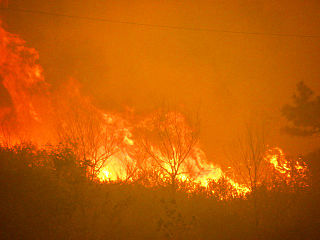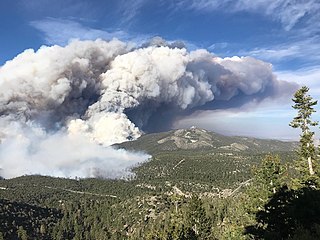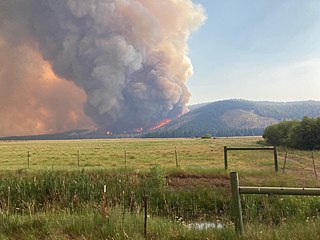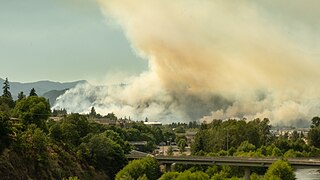Related Research Articles

The 2012 Colorado wildfires were an unusually devastating series of Colorado wildfires, including several separate fires that occurred throughout June, July, and August 2012. At least 34,500 residents were evacuated in June.

2014 saw several notable wildfires igniting in California, especially during the month of May, when multiple fires were ablaze concurrently in Southern California, and during September, when several massive wildfires were burning in Northern California. In the context of the 2012–13 North American drought, as well as powerful Santa Ana winds, weather conditions were ideal for wildfires. A total of 7,865 wildfires ignited throughout the year, which burned at least 625,540 acres (2,531.5 km2) of land. The wildfires caused a total of 146 injuries and 2 fatalities, in addition to causing at least $204.05 million in damage.

The Eagle Creek Fire was a destructive wildfire in the Columbia River Gorge, largely in the U.S. state of Oregon, with smaller spot-fires in Washington. The fire was started on September 2, 2017, by a 15-year-old boy igniting fireworks during a burn ban. The fire burned 50,000 acres, and burned for three months, before being declared completely contained. As late as May 29, 2018, it was still found smoldering in some areas.

The 2020 Utah wildfire season was a series of prominent wildfires throughout the state of Utah, lasting from June 1 through October 30, as defined by state law. Part of the 2020 Western United States wildfire season, Utah saw record-breaking numbers of human-caused fires. The largest fire of the season, the East Fork Fire, burned an area of 89,568 acres. In total, the suppression costs for the fires amounted to at least $103 million.

The Mahogany Fire was a wildfire that burned on Mount Charleston in the Spring Mountains National Recreation Area, approximately 50 miles northwest of Las Vegas, Nevada in the United States. The fire was first reported on June 28, 2020. The fire burned a total of 2,758 acres (1,116 ha) and was contained on July 7, 2020. The cause of the fire remains under investigation. The fire impacted recreational activities and roadways in the area, including closing a children's summer camp and evacuating Lee Canyon. Additionally, three state highways were closed in the area to allow ease of access for crews and to limit the public's access to the fire area.

The 2020 Oregon wildfire season was one of the most destructive on record in the state of Oregon. The season is a part of the 2020 Western United States wildfire season. The fires killed at least 11 people, burned more than 1,000,000 acres (400,000 ha) of land, and destroyed thousands of homes.

The 2020 Creek Fire was an enormous and destructive wildfire in central California's Sierra National Forest, in Fresno and Madera counties. One of the most significant fires of California's record-setting 2020 wildfire season, it began on September 4, 2020, and burned 379,895 acres (153,738 ha) over several months until it was declared 100% contained on December 24, 2020. The Creek Fire is the fifth-largest wildfire in recorded California history and the second-largest single fire—i.e. not part of a larger wildfire complex—following the 2021 Dixie Fire.

The North Complex Fire was a massive wildfire complex that burned in the Plumas National Forest in Northern California in the counties of Plumas and Butte. 21 fires were started by lightning on August 17, 2020; by September 5, all the individual fires had been put out with the exception of the Claremont and Bear Fires, which merged on that date, and the Sheep Fire, which was then designated a separate incident. On September 8, strong winds caused the Bear/Claremont Fire to explode in size, rapidly spreading to the southwest. On September 8, 2020, the towns of Berry Creek and Feather Falls were immediately evacuated at 3:15 p.m. PDT with no prior warning, By September 9, 2020, the towns of Berry Creek and Feather Falls had been leveled, with few homes left standing. The fire threatened the city of Oroville, before its westward spread was stopped. The fire killed 16 people and injured more than 100. Among the 16 fatalities was a 16-year-old boy. The complex burned an estimated 318,935 acres (129,068 ha), and was 100% contained on December 3. The fire was managed by the U.S. Forest Service in conjunction with Cal Fire, with the primary incident base in Quincy. The North Complex Fire was the sixth-largest in California's modern history, and the deadliest fire in the 2020 California wildfire season.

The Western United States experienced a series of major wildfires in 2020. Severe August thunderstorms ignited numerous wildfires across California, Oregon, and Washington, followed in early September by additional ignitions across the West Coast. Fanned by strong, gusty winds and fueled by hot, dry terrains, many of the fires exploded and coalesced into record-breaking megafires, burning more than 10.2 million acres of land, mobilizing tens of thousands of firefighters, razing over ten thousand buildings, and killing at least 37 people. The fires caused over $19.884 billion in damages, including $16.5 billion in property damage and $3.384 billion in fire suppression costs. Climate change and poor forest management practices contributed to the severity of the wildfires.
The Willow Fire was a wildfire that burned in the Ventana Wilderness in Monterey County, California, in the United States as part of the 2021 California wildfire season. The fire started on June 17, 2021, burned 2,877 acres (1,164 ha), and was fully contained on July 12, 2021.

The Lava Fire was a wildfire that burned 26,409 acres (10,687 ha) along the slopes of Mount Shasta near Weed, California during the 2021 California wildfire season. The fire started on June 25, 2021 and was fully contained on September 3, 2021. The fire destroyed 23 buildings, including 14 houses, as well as damaged an additional building.

The 2021 Dixie Fire was an enormous wildfire in Butte, Plumas, Lassen, Shasta, and Tehama counties in Northern California. Named after a nearby Dixie Road, the fire began in the Feather River Canyon near Cresta Dam in Butte County on July 13, 2021, and burned 963,309 acres (389,837 ha) before it was declared 100 percent contained on October 25, 2021. It was the largest single wildfire in recorded California history, and the second-largest wildfire overall, The fire damaged or destroyed several communities, including Greenville on August 4, Canyondam on August 5, and Warner Valley on August 12.

The Tennant Fire was a wildfire that burned in the Klamath National Forest in Siskiyou County, California, in the United States as part of the 2021 California wildfire season. The fire was first reported just east of Highway 97, three miles northwest of Bray, California on June 28, 2021. The fire was contained on July 12, 2021. The fire burned 10,580 acres (4,282 ha), destroyed five structures, and caused evacuations in Macdoel, California. The cause remains under investigation. The Tennant Fire was one of three fires burning at the same time in the Lake Shasta region, the others being the Lava Fire and the Salt Fire.
The River Fire was a wildfire that burned 2,619 acres (1,060 ha) in the Colfax area in Nevada County and Placer County, California, in the United States during the 2021 California wildfire season. The fire was first reported on Wednesday, August 4, 2021, and was fully contained on Friday, August 13, 2021. The River Fire destroyed 142 structures, damaged 21 more, and resulted in 4 injuries to firefighters and civilians. It was the fifth most destructive fire of 2021 in California. The exact cause of the fire is unknown, but CAL FIRE officials stated after an investigation that it had been "determined to be of human cause," originating in the overnight camping area of Bear River Campground west of Colfax.

The McKinney Fire was a destructive wildfire in the Klamath National Forest in western Siskiyou County during the 2022 California wildfire season. The fire was named for its ignition point near McKinney Creek Road, where the fire began on July 29, 2022, at approximately 2:15 p.m. PDT. The McKinney Fire experienced explosive weather-driven growth over the next day and a half, consuming more than 50,000 acres in less than 36 hours, destroying at least 185 structures and causing 4 fatalities.

The 2023 Washington wildfire season officially began in March 2023 in the US state of Washington.

The Tunnel Five Fire or Tunnel 5 Fire was a wildfire in Skamania County, Washington in the Columbia River Gorge, near the border with Oregon. Ignited in the morning of July 2, 2023, the cause of the fire is still under investigation. By July 10, the fire was 80% contained, and by the following day it reached 100% containment.
The Flat Fire is an active wildfire near Agness, Oregon in Siskiyou National Forest. Ignited at about 5:51 PM PT on July 15, 2023, the fire was human caused. As of August 26, 2023, the fire has burned 34,242 acres (13,857 ha) and is 58% contained.
The Newell Road Fire was a wildfire in Klickitat County, Washington, United States. The fire began near Roosevelt at about 3:20 pm Pacific Time on July 21, 2023 and burned 60,551 acres (24,504 ha). It was 100% contained on July 29, 2023. The cause of the fire is still unknown and under an active investigation.
The Oregon Fire was a wildfire that burned in Spokane County, Washington and Pend Oreille County, Washington, United States. As of September 15, 2023, the fire had burned 10,817 acres (4,377 ha) and was 97% contained. In addition to burning 384 structures, 126 of which were primary residences, the death of one person was determined to be connected to the fire.
References
- ↑ "InciWeb - Boulder Fire Information". inciweb.wildfire.gov. December 4, 2023. Retrieved December 5, 2023.
- ↑ "NWCC :: Home". gacc.nifc.gov. Retrieved July 8, 2023.
- ↑ Staff, FOX 12 (July 9, 2023). "Level 3 evacuations issued for Boulder Fire near Mt. Hood". www.kptv.com. Retrieved July 9, 2023.
{{cite web}}: CS1 maint: numeric names: authors list (link)